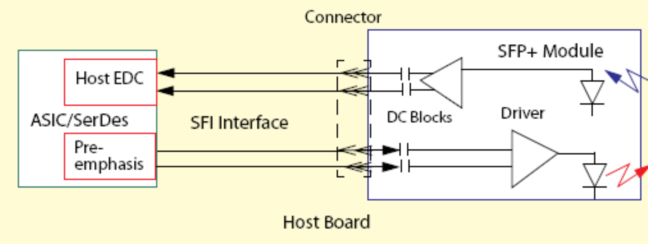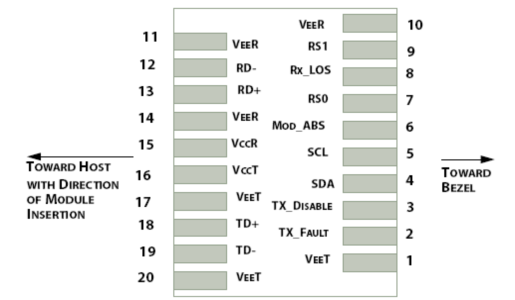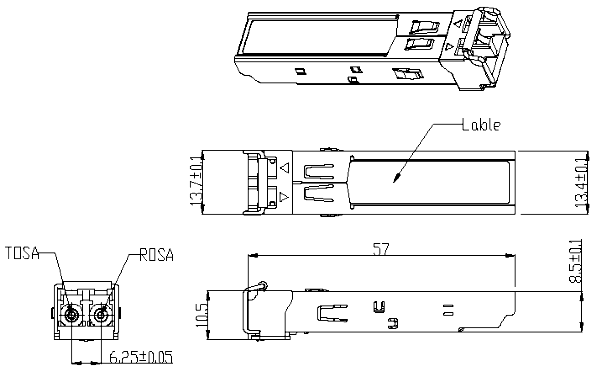TGL–SFP+-SR 10Gbps SFP+ Transceiver, 300m Reach
Features
*Optical interface compliant to IEEE 802.3ae 10GBASE-SR *Electrical interface compliant to SFF-8431 *Hot Pluggable *850nm VCSEL transmitter, PIN photo-detector *Maximum link length of 300m on 2000MHz/km MMF *Operating case temperature: 0 to 70℃ *Low power consumption *All-metal housing for superior EMI performance *Advanced firmware allow customer system encryption information to be stored in transceiver *Cost effective SFP+ solution, enables higher port densities and greater bandwidth
Applications
*10GBASE-SR at 10.3125Gbps *10GBASE-SW at 9.953Gbps *Other optical links
Product description
This 850nm VCSEL 10Gigabit SFP+ transceiver is designed to transmit and receive optical data over 50/125 μm or 62.5/125 μm multimode optical fiber (Table 1).
Table 1: SFP+ SR Operating Range for each Optical Fiber Type
The SFP+ SR module electrical interface is compliant to SFI electrical specifications. The transmitter input and receiver output impedance is 100 Ohms differential. Data lines are internally AC coupled. The module provides differential termination and reduce differential to common mode conversion for quality signal termination and low EMI. SFI typically operates over 200 mm of improved FR4 material or up to about 150mmof standard FR4 with one connector.
The transmitter converts 10Gbit/s serial PECL or CML electrical data into serial optical data compliant with the 10GBASE-SR standard. An open collector compatible Transmit Disable (Tx_Dis) is provided. A logic “1,” or no connection on this pin will disable the laser from transmitting. A logic “0” on this pin provides normal operation. The transmitter has an internal automatic power control loop (APC) to ensure constant optical power output across supply voltage and temperature variations. An open collector compatible Transmit Fault (TFault) is provided. TX_Fault is a module output contact that when high, indicates that the module transmitter has detected a fault condition related to laser operation or safety. The TX_Fault output contact is an open drain/collector and shall be pulled up to the Vcc_Host in the host with a resistor in the range 4.7-10 kΩ. TX_Disable is a module input contact. When TX_Disable is asserted high or left open, the SFP+ module transmitter output shall be turned off. This contact shall be pulled up to VccT with a 4.7 kΩ to 10 kΩ resistor
The receiver converts 10Gbit/s serial optical data into serial PECL/CML electrical data. An open collector compatible Loss of Signal is provided. Rx_LOS when high indicates an optical signal level below that specified in the relevant standard. The Rx_LOS contact is an open drain/collector output and shall be pulled up to Vcc_Host in the host with a resistor in the range 4.7-10 kΩ, or with an active termination. Power supply filtering is recommended for both the transmitter and receiver. The Rx_LOS signal is intended as a preliminary indication to the system in which the SFP+ is installed that the received signal strength is below the specified range. Such an indication typically points to non-installed cables, broken cables, or a disabled, failing or a powered off transmitter at the far end of the cable.
Figure 1: Interface to Host
Pin definition
The SFP+ modules are hot-pluggable. Hot pluggable refers to plugging in or unplugging a module while the host board is powered. The SFP+ host connector is a 0.8 mm pitch 20 position right angle improved connector specified by SFF-8083, or stacked connector with equivalent with equivalent electrical performance. Host PCB contact assignment is shown in Figure 2 and contact definitions are given in Table 2. SFP+ module contacts mates with the host in the order of ground, power, followed by signal as illustrated by Figure 3 and the contact sequence order listed in Table 2.
Figure 2: Interface to Host PCB
Figure 3: Module Contact Assignment
Optical characteristics
The following optical characteristics are defined over the Recommended Operating Environment unless otherwise specified.
|
Parameter |
Symbol |
Min. |
Typical |
Max |
Unit |
Notes |
|
Transmitter |
||||||
|
Center Wavelength |
λt |
840 |
850 |
860 |
nm |
|
|
RMS spectral width |
Pm |
– |
– |
Note 1 |
nm |
|
|
Average Optical Power |
Pavg |
-6.5 |
– |
-1 |
dBm |
2 |
|
Extinction Ratio |
ER |
3.5 |
– |
– |
dB |
3 |
|
Transmitter Dispersion Penalty |
TDP |
– |
– |
3.9 |
dB |
|
|
Relative Intensity Noise |
Rin |
– |
– |
-128 |
dB/Hz |
12dB reflection |
|
Optical Return Loss Tolerance |
|
– |
– |
12 |
dB |
|
|
Receiver |
||||||
|
Center Wavelength |
λr |
840 |
850 |
860 |
nm |
|
|
Receiver Sensitivity |
Psens |
– |
– |
-11.1 |
dBm |
4 |
|
Stressed Sensitivity in OMA |
|
– |
– |
-7.5 |
dBm |
4 |
|
Los function |
Los |
-30 |
– |
-12 |
dBm |
|
|
Overload |
Pin |
– |
– |
-1.0 |
dBm |
4 |
|
Receiver Reflectance |
|
– |
– |
-12 |
dB |
|
Note 1.Trade-offs are available between spectral width, center wavelength and minimum OMA, as shown in table 6.
2.The optical power is launched into MMF
3.Measured with a PRBS 231-1 test pattern @10.3125Gbps
4.Measured with a PRBS 231-1 test pattern @10.3125Gbps,BER≤10-12.
Figure 3: Key Mechanical Dimensions
Ordering information
|
Part Number |
Product Description |
|
TGL-SFP+-SR |
850nm, 10Gbps, 300m,LC, 0ºC ~ +70ºC |




